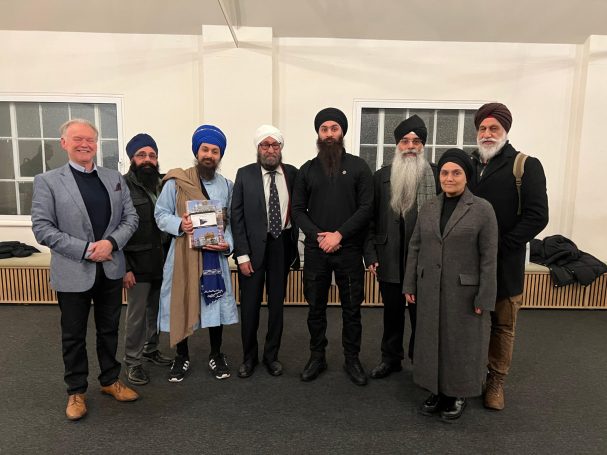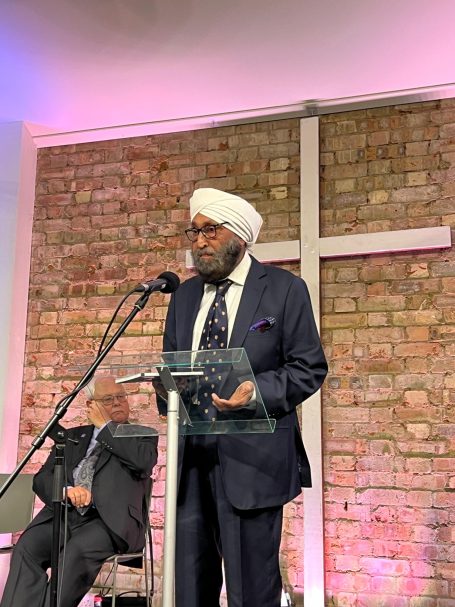From Genocide to Self-Determination – The Sikh Case
Book launch speech by Keith Best on 2 February 2024 in The King’s House, London
Genocide in itself is a manifestation of the baser motives of demagogues, dictators, populists and tyrants down the ages – the supposed ability to garner unification of support by directing a common hatred or blame against an identifiable distinct group. We have seen many examples in history and the current day. Genocide but without that name, of course, has happened throughout history with perhaps the most egregious example being the Holocaust which annual memorial day has just passed in which 6m mainly Jews but also gypsies, disabled and others were systematically murdered on an scale using industrial means of killing. It was that which ensured, rather late in history and only comparatively recently, this abhorrence was encapsulated in law as a crime. The term “genocide” was first conceived by the Polish Jewish lawyer Raphael Lemkin in his 1944 book Axis Rule in Occupied Europe in which he was very much motivated by the Armenian genocide which, at that time, was not an international crime. He remained dissatisfied that the Nuremberg Trial only dealt with genocide in wartime and did not extend to the Nazi atrocities prior to the Second World War. Nevertheless, he can be seen as the main author of the Genocide Convention of 1948.
Indeed, at the Nuremberg Tribunal Trials the term genocide was nearly omitted altogether and, in fact, was not alleged as a separate crime from the charges of crimes against peace, war crimes and crimes against humanity, to Lemkin’s disappointment. His persistence, however, meant that the indictment of war crimes was described as the “murder and ill-treatment of civilians” committed by the defendants as “deliberate and systematic genocide, viz., the extermination of racial and national groups.” The Tribunal prosecutors repeatedly employed the term genocide during the trials but the judges did not adopt it in their verdict. Lemkin had developed the concept alongside the other great author of the Nuremberg juridical architecture, Hersch Lauterpacht, who worked on crimes against humanity and whom I studied as a young law student at Oxford University. I commend to you all the book East West Street by noted international lawyer Philippe Sands KC who traces their families both from the City of Lviv and how they came to develop their respective legal themes.
In our lifetimes we have seen the Amhara, Rwandan, Bosnian, Cambodian, Rohingya and now the Uighyur genocides among others which go largely unpunished. It remains a matter of gravest international concern. Genocide is the deliberate and systematic destruction, in whole or in part, of an ethnic, racial, religious, or national group.
It is defined in Article 2 of the Convention on the Prevention and Punishment of the Crime of Genocide (CPPCG) of 1948 as “any of the following acts committed with intent to destroy, in whole or in part, a national, ethnical, racial, or religious group, as such: killing members of the group; causing serious bodily or mental harm to members of the group; deliberately inflicting on the group’s conditions of life, calculated to bring about its physical destruction in whole or in part; imposing measures intended to prevent births within the group; [and] forcibly transferring children of the group to another group.”
This book is by distinguished Mr Justice Dr Anup Singh Choudry formerly of the High Court of Uganda where he was born and in the then War Crimes Division in Uganda’s High Court. He authored the earlier acclaimed book Sikh Genocide 84 in 2018and this is a sequel. It is well researched and covers many historical events with evidence and press reports including examination of other genocides in Armenia, Chechnya and against the Rohingya among others. It is also full of well documented opinions. International lawyers will argue about whether the storming of the Golden Temple in 1984 and subsequent events amounted to genocide in its technical sense but for anyone considering the matter this is essential background reading. The book also covers other interesting concepts and political theories as well as the impact of genocide on the development of self-determination and cohesion of the state and looks at the post-genocide impossibility of victims and perpetrators co-existing. Once genocide has been initiated a Rubicon has been crossed and it has wide-ranging and lasting impact. We still see today the discomfort of those countries that were occupied by the Nazis and the Soviets in the Second World War where some citizens sided or collaborated with the invader which leaves a generational question as to the capacity to live with one’s neighbours.
From the Sikh perspective there can be no doubt that the events of 1984 and the call for a separate state of Khalistan as a Sikh homeland are inextricably entwined. Borders are the historic legacy which, arguably, have been the cause of more conflict than any other reason. Created so often by conquest, flawed treaties and decolonisation they have cut through tribal, linguistic, cultural and historic ties leaving a trail of dissatisfaction and uncertainty. The Punjab, a unified Sikh territory was divided on Partition in August 1947. I have been to both Indian and Pakistan Punjab and conjured one of the what-ifs of history of how strong a state a unified Punjab would now be. That same transference of rule from Britain, Partition, which left such a terrible consequent movement and death of millions, has left to this day a “line of control” between India and Pakistan which is shown as disputed territory and a series of dots rather than a solid line on Indian maps. I have been many times and opened an immigration advisory office in Mirpur in Azad Kashmir which is still disputed between those two nations and by the desire of the population to have self-determined autonomy. I have heard on my visits the Indian artillery firing shells for target practice into the villages in the Pakistan administered area.
I wish to draw attention again to the Rohingya whom I mentioned as their plight has given rise to some interesting developments in international law. It was thought initially that the International Criminal Court, which includes the crime of genocide in its panoply of offences, could have no jurisdiction because Myanmar is not a signatory to the Rome Statute. The Chief Prosecutor and the Court found a way around that by ruling that the crime continued on the soil of Bangladesh to which the Rohingya had fled and which is a signatory. Moreover, the Gambia, now supported by other nations, has taken Myanmar to the International Court of Justice (ICJ) on the basis that it has violated the Genocide Convention and separately Argentina is claiming universal jurisdiction for the crime of genocide – in other words the capacity for it to be tried in any national court of law whether the court is in a state party to the Convention or in a non-state party. In his introduction to the book Anup Choudry states that the ICJ has determined that not only is genocide part of customary international law but that also it is a peremptory norm of international law or ius cogens which means that it is not only universally applicable to all states but also that no derogation from it is permitted, as stated by the UN Office on Genocide Prevention.
These are powerful arguments and make this book an essential part of any library on the subject.
©Copyright. All rights reserved.
We need your consent to load the translations
We use a third-party service to translate the website content that may collect data about your activity. Please review the details in the privacy policy and accept the service to view the translations.


